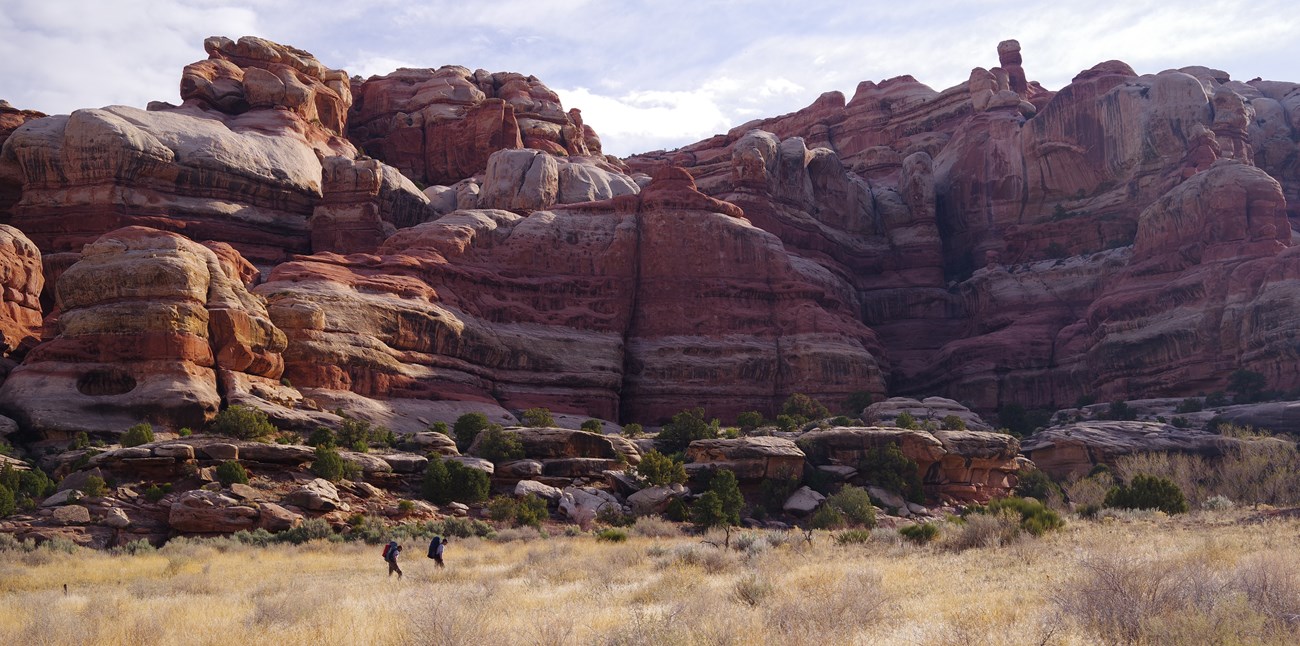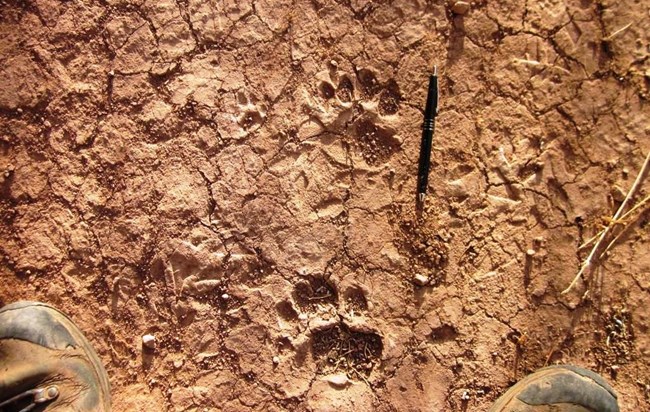
NPS The Salt Creek Trail follows the main wash past cottonwood groves, through sections of reeds and willows, and across sagebrush flats. The trail can be obscured by dense vegetation, impacted by seasonal flooding, and be difficult to follow. Conditions may be wet, depending on the season. Hikers should be prepared to bushwhack to navigate through areas, especially between the southern park boundary and Kirk Spring. Mosquitos and gnats can be prevalent from early summer through autumn. There are several arches, historic, and culturally signficant sites that can be seen from the trail. Numerous side canyons also offer opportunities to explore, but any off trail travel should be on slickrock or along sandy washes; keep off biological soil crust and vegetation. Visitors are welcome to explore the backcountry and view archeological and cultural sites; however, entering archeological sites is prohibited by federal law except in areas designated by the NPS. The law also prohibits altering, damaging, collecting, or touching any surface features (petroglyphs, pictographs, ceramics, tools, lithics, etc). Areas open for visitation will be signed or otherwise indicated on NPS brochures and waysides. Further information on these areas can be obtained from a ranger at the visitor center. 
NPS/Jen Mitchell Trailhead AccessBackpackers can either hike through Upper Salt Creek or as an out-and-back trip from either trailhead. A thru hike requires a vehicle shuttle; visitors must organize their own shuttle or contact a commercial shuttle service out of Moab. Roads leading to either end of Salt Creek Trail can be impassable or require a high clearance 4WD vehicle to reach. Check road conditions before starting your trip.Cathedral Butte Trailhead is located outside the park approximately 18 miles down Beef Basin Road/Bridger Jack Road/CR-107. The road may be impassable during winter or require a high-clearance 4WD vehicle when flooded in areas. Hikers must descend 1,500 ft from the trailhead on loose, steep terrain to reach Salt Creek Canyon. Peekaboo 4WD Road is frequently impassable to vehicles. Parking near Peekaboo or along the Salt Creek/Horse Canyon 4WD road is strongly discouraged due to high potential for flash flood danger. Backpackers should plan to park at the Cave Springs/Salt Creek Gate and walk the road to Peekaboo. Another option is starting or ending from the Needles Campground Trailhead. This involves hiking the Peekaboo Trail and then continuing south into Salt Creek Canyon. The campground trailhead can fill up on weekends during spring, fall, and holidays. Trip Planning MapThis map shows the Salt Creek, Peekaboo, and Angel Arch trails as well as designated campsites and the Salt and Horse at-large zone boundaries. We strongly recommend backpackers consult a topographic map for distances between campsites and trailheads.
NPS/Angela Sowa BackpackingThere are both designated campsites and an at-large backpacking zone within Salt Creek Canyon available for reservation on Recreation.gov:
Most backpackers spend 2-3 nights in Salt Creek Canyon. Due to deep sand and dense vegetation along the trail, it is not recommended to attempt a thru hike in two days or less. Backpackers must stay in the campsite or zone they reserved each night. Plan accordingly based on mileage and daylight hours to reach your campsite. Dispersed camping within Salt Creek Canyon is not allowed. The at-large zone is for a specific area, must be reserved on a permit, and does not include the entire canyon. Waste RequirementsCommercial, landfill safe human waste bags are required at all Salt Creek designated campsites and strongly recommended within the at-large zone. Solid human waste is unlikely to decompose, can pollute water sources, and harm the environment within Salt Creek Canyon. 
NPS Food StorageBears have been sighted in Salt Creek Canyon and many neighboring canyons in The Needles. Backpackers should keep a clean camp and store food items securely. Backpackers at Salt Creek designated campsites, Peekaboo campsites, and the Salt/Horse Zone are required to store all food, beverages, and associated containers, garbage, and scented items in a hard-sided, park-approved animal-resistant food container, capable of preventing access by wildlife, at least 100 feet from camp from March 15 to November 30. Ursacks and other soft animal resistant containers do not meet this requirement. 
NPS Cultural ResourcesPeople have lived in and traveled through what is now Canyonlands National Park for over 10,000 years. During that time, they left evidence of their presence that are protected in the park today. Salt Creek Canyon is part of the Salt Creek Archeological District, a cultural landscape that is listed on the National Register of Historic Places. Open air and alcoved sites are vulnerable to the impact of cumulative visitation. |
Last updated: April 29, 2025
